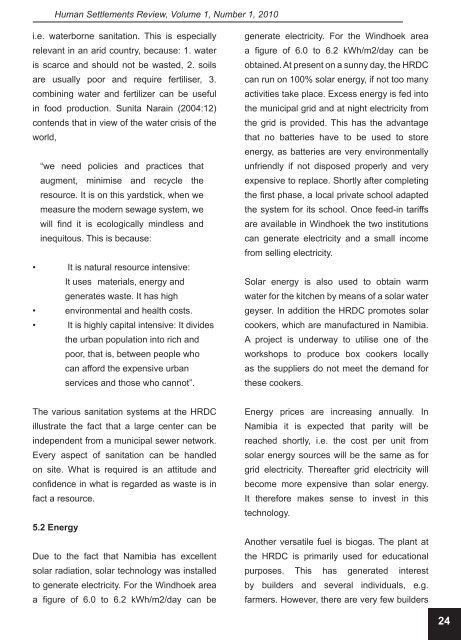Human Settlements Review - Parliamentary Monitoring Group
Human Settlements Review - Parliamentary Monitoring Group
Human Settlements Review - Parliamentary Monitoring Group
Create successful ePaper yourself
Turn your PDF publications into a flip-book with our unique Google optimized e-Paper software.
<strong>Human</strong> <strong>Settlements</strong> <strong>Review</strong>, Volume 1, Number 1, 2010<br />
i.e. waterborne sanitation. This is especially<br />
relevant in an arid country, because: 1. water<br />
is scarce and should not be wasted, 2. soils<br />
are usually poor and require fertiliser, 3.<br />
combining water and fertilizer can be useful<br />
in food production. Sunita Narain (2004:12)<br />
contends that in view of the water crisis of the<br />
world,<br />
“we need policies and practices that<br />
augment, minimise and recycle the<br />
resource. It is on this yardstick, when we<br />
measure the modern sewage system, we<br />
will find it is ecologically mindless and<br />
inequitous. This is because:<br />
• It is natural resource intensive:<br />
It uses materials, energy and<br />
generates waste. It has high<br />
• environmental and health costs.<br />
• It is highly capital intensive: It divides<br />
the urban population into rich and<br />
poor, that is, between people who<br />
can afford the expensive urban<br />
services and those who cannot”.<br />
generate electricity. For the Windhoek area<br />
a figure of 6.0 to 6.2 kWh/m2/day can be<br />
obtained. At present on a sunny day, the HRDC<br />
can run on 100% solar energy, if not too many<br />
activities take place. Excess energy is fed into<br />
the municipal grid and at night electricity from<br />
the grid is provided. This has the advantage<br />
that no batteries have to be used to store<br />
energy, as batteries are very environmentally<br />
unfriendly if not disposed properly and very<br />
expensive to replace. Shortly after completing<br />
the first phase, a local private school adapted<br />
the system for its school. Once feed-in tariffs<br />
are available in Windhoek the two institutions<br />
can generate electricity and a small income<br />
from selling electricity.<br />
Solar energy is also used to obtain warm<br />
water for the kitchen by means of a solar water<br />
geyser. In addition the HRDC promotes solar<br />
cookers, which are manufactured in Namibia.<br />
A project is underway to utilise one of the<br />
workshops to produce box cookers locally<br />
as the suppliers do not meet the demand for<br />
these cookers.<br />
The various sanitation systems at the HRDC<br />
illustrate the fact that a large center can be<br />
independent from a municipal sewer network.<br />
Every aspect of sanitation can be handled<br />
on site. What is required is an attitude and<br />
confidence in what is regarded as waste is in<br />
fact a resource.<br />
5.2 Energy<br />
Due to the fact that Namibia has excellent<br />
solar radiation, solar technology was installed<br />
to generate electricity. For the Windhoek area<br />
a figure of 6.0 to 6.2 kWh/m2/day can be<br />
Energy prices are increasing annually. In<br />
Namibia it is expected that parity will be<br />
reached shortly, i.e. the cost per unit from<br />
solar energy sources will be the same as for<br />
grid electricity. Thereafter grid electricity will<br />
become more expensive than solar energy.<br />
It therefore makes sense to invest in this<br />
technology.<br />
Another versatile fuel is biogas. The plant at<br />
the HRDC is primarily used for educational<br />
purposes. This has generated interest<br />
by builders and several individuals, e.g.<br />
farmers. However, there are very few builders<br />
24









![National Research Foundation Annual Report 2008 / 2009 [Part 2]](https://img.yumpu.com/49774036/1/177x260/national-research-foundation-annual-report-2008-2009-part-2.jpg?quality=85)







